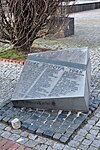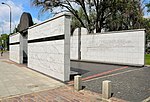Miła 18
Buildings and structures in WarsawHistory of WarsawInfrastructure completed in 1943Jewish Polish historyJewish resistance during the Holocaust ... and 4 more
Mass suicidesMonuments and memorials in WarsawTourist attractions in WarsawWarsaw Ghetto Uprising

Ulica Miła 18 (or 18 Pleasant Street in English) was the headquarters "bunker" (actually a hidden shelter) of the Jewish Combat Organization (ŻOB), a Jewish resistance group in the Warsaw Ghetto in Poland during World War II.
Excerpt from the Wikipedia article Miła 18 (License: CC BY-SA 3.0, Authors, Images).Miła 18
Miła, Warsaw Śródmieście (Warsaw)
Geographical coordinates (GPS) Address External links Nearby Places Show on map
Geographical coordinates (GPS)
| Latitude | Longitude |
|---|---|
| N 52.2515 ° | E 20.9923 ° |
Address
Kopiec Mordechaja Anielewicza
Miła
00-174 Warsaw, Śródmieście (Warsaw)
Masovian Voivodeship, Poland
Open on Google Maps











